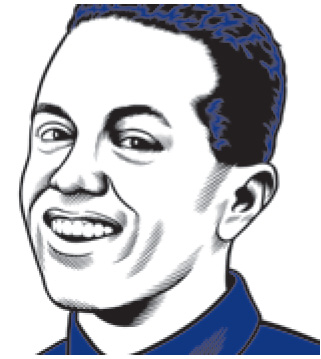Believed to be deaf, Shawn Nelson Schmitt didn’t speak until he was nine years old, an experience that has fueled his study of Deaf culture (capitalized to distinguish between people who identify with a Deaf culture and people who have a hearing difference but who do not identify with a Deaf culture) through sociological and psychological lenses. He is a PhD candidate in clinical psychology at Gallaudet University.
—Catherine Lacey
THE BELIEVER: What was your first language?
SHAWN NELSON SCHMITT: I began acquiring Signing Exact English (SEE) at birth and started formal instruction in spoken and written English at age nine.
BLVR: How did you manage to avoid speaking for so long even though you had the ability to hear? Were you homeschooled before then?
SNS: This occurred because I was misidentified as deaf from birth. My parents were both born with total bilateral hearing loss as a result of a genetic mutation in the connexin 26 gene; while I do not know much about my paternal lineage, I know that my mother was the only deaf child of twelve. I went to a deaf program at a public school until age nine.
BLVR: How were you diagnosed as deaf, and what prompted your teachers to realize you had been misdiagnosed?
SNS: The hearing test was less rigorous for me than it was for my siblings. When I did not respond to auditory stimuli, my mother and the doctor reached that conclusion.
BLVR: Was there any point before the age of nine that you realized you were not actually deaf?
SNS: Not that I can recall. While I could hear, I assumed that my mother and her deaf friends experienced those same auditory stimuli but that they did not respond to them.
BLVR: Though you weren’t verbal, you could still make noises, right? Did you ever mimic what you heard around you before the age of nine?
SNS: To clarify, the archaic terminology of “deaf and dumb” and “deaf-mute” referred to the audiological component of a hearing difference as well as the tendency for deaf and hard-of-hearing people not to speak or otherwise use their voices. On the contrary, I know of very few deaf and hard-of-hearing people who have physiological constraints that prevent sound production; such issues do not seem to relate to audiological deafness per se. I may have babbled in or mimicked spoken English before age nine, but it was not the primary language in my family.
BLVR: What was your first spoken word? Your first signed?
SNS: My first sign was Mom, and my first spoken word was doughnut. The hand-shape for the sign of mother is often one of the first that children acquire, at...
You have reached your article limit
Sign up for a digital subscription and continue reading all new issues, plus our entire archives, for just $1.50/month.
Already a subscriber? Sign in





